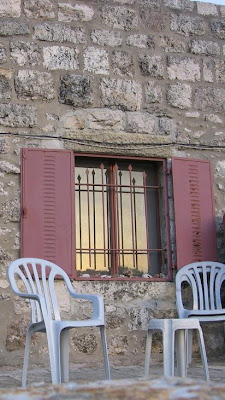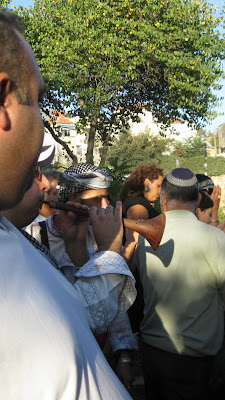.
Today was the festive day called Hoshana Rabba. To see the throngs of worshippers at the Western Wall please see my
post from last year.
.
Tonight and tomorrow, immediately following the 7-day Sukkot festival, we have Simchat Torah (meaning "Rejoicing of the Torah"). In the synagogue the annual Torah reading cycle is completed and begun anew. The end of the fifth book of Moses is read, the scroll is rewound, and the first part of Genesis is chanted.
.
As the
Chabad website says, "The event is marked with great rejoicing, especially during the 'hakafot' procession, in which we march, sing and dance with the Torah scrolls around the reading table in the synagogue. 'On Simchat Torah,' goes the chassidic saying, 'we rejoice in the Torah, and the Torah rejoices in us; the Torah, too, wants to dance, so we become the Torah's dancing feet.'"

At Hadassah hospital's synagogue the Torah scrolls stand in this Holy Ark.
The ark doors are covered by a parochet.
This very special ark covering was designed and created by American-Israeli artist Aviva Green in 1981-82.
The stylized Hebrew calligraphy says "Da lifne mi ata omed," the exhortation "Know before whom you stand."
 The Torah is opened and read on the reading table in the center of the synagogue. Here, too, the artist created a soft sculpture to cover the table, in wool, cotton, silk, hemp, and metallic thread. It can be seen better, without the glass, in a slideshow at the artist's website.
The Torah is opened and read on the reading table in the center of the synagogue. Here, too, the artist created a soft sculpture to cover the table, in wool, cotton, silk, hemp, and metallic thread. It can be seen better, without the glass, in a slideshow at the artist's website.
The artist explains in just a few wonderful paragraphs how she came to the ideas for her Two-Piece Soft Sculpture.

And above it all are the twelve glorious stained glass windows by Marc Chagall!
For more about the vitrage work please see my earlier
post.
.
Shabbat shalom and happy Simchat Torah!
.
 I have been in Tiberias doing archaeology two weeks now (one more week to go) and most of the hot days were hazy like in this shot taken at 4 pm.
I have been in Tiberias doing archaeology two weeks now (one more week to go) and most of the hot days were hazy like in this shot taken at 4 pm.














